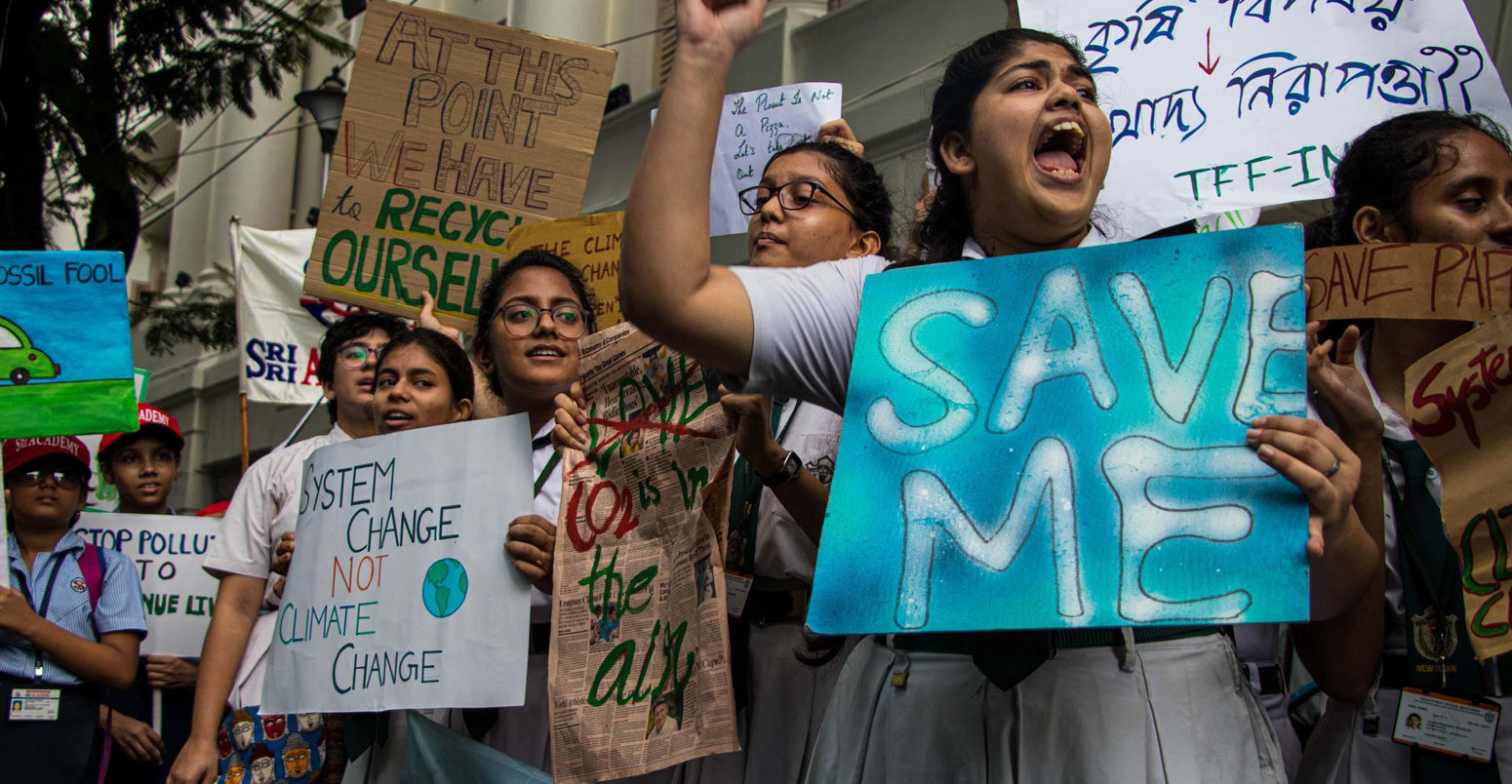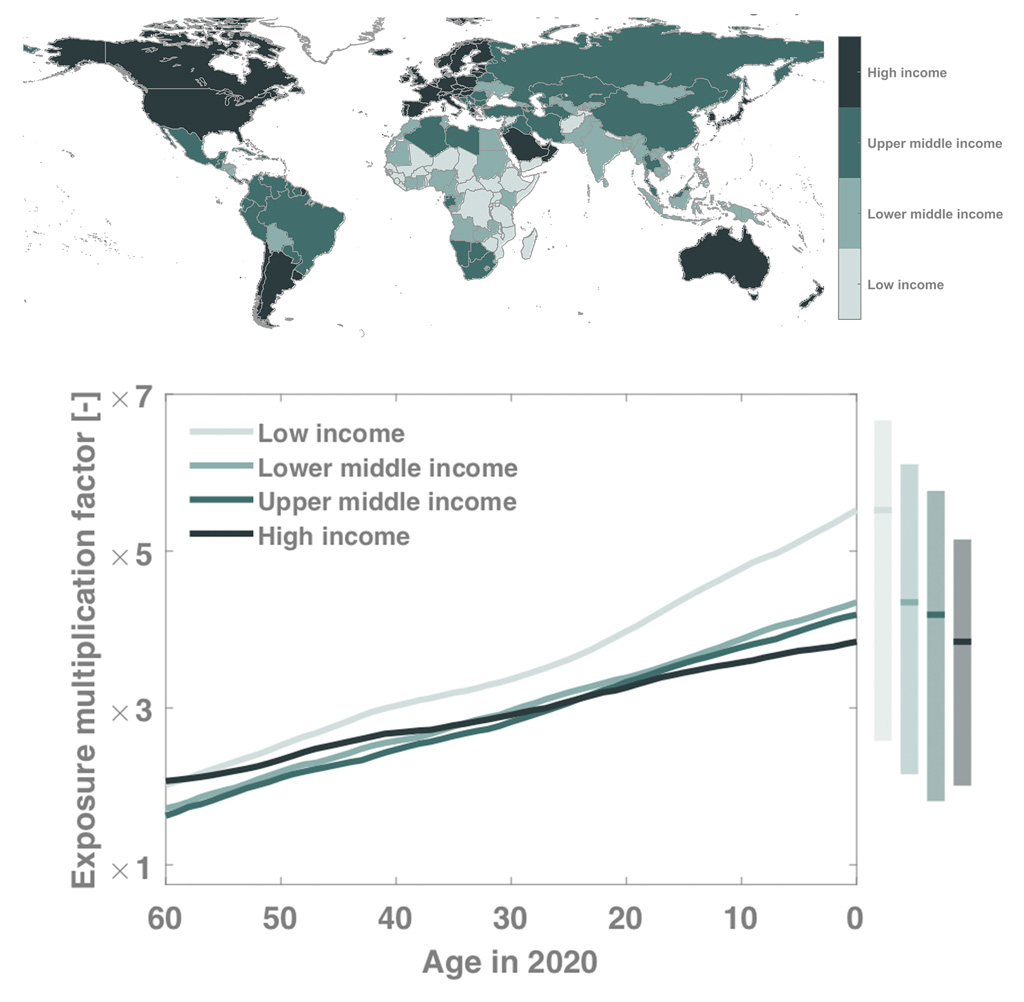
Today’s youth will face ‘unmatched’ climate extremes compared to older generations
Ayesha Tandon
09.27.21Ayesha Tandon
27.09.2021 | 12:01amPeople born in 2020 will have to face between two and seven times more extreme climate-related events over their lifetimes than people born in 1960, according to estimates from a new study.
The paper, published in Science, analyses six extreme event categories – including crop failures, droughts and heatwaves. It finds that even if warming is limited to 1.5C, younger generations will face “unavoidable impacts that are unmatched by those experienced by older generations” over the course of their lives.
The study estimates that people born in 1960 will experience four heatwaves over their lifetimes on average. However, children born in 2020 will have to face 30 if the current emission pledges made under the Paris Agreement are met, and 18 if warming is limited to 1.5C.
The authors find a “particularly strong increase” in childrens’ future exposure to extremes in the Middle East and North Africa. They also emphasise that younger generations from low-income countries – where populations are generally rising – will face greater exposure to extremes than children in high-income countries.
Today’s youth will live “an unprecedented life”, in which they will “face conditions which older generations have never experienced”, the lead author of the study tells Carbon Brief.
A scientist not involved in the study adds that the study “scientifically underpins the motivation for the protests of hundreds of thousands of students – that is, that they pay the price and suffer from the consequences of the lifestyle and emissions of their parents and grandparents”.
Intergenerational climate justice
It is well established that a warming climate is seeing – and will see – an increasing frequency and intensity of climate-related extremes. Yet today’s youth – who will face the brunt of the impacts – are not responsible for historical emissions.
Carbon Brief analysis has previously shown that in order to limit global warming to 1.5C, today’s youth will need to emit eight times less CO2 than their grandparents did over their lifetimes.
The fact that younger generations will inevitably face the worst impacts of climate change, despite contributing the least towards emissions, is a cornerstone of the intergenerational climate justice movement – and has been a driving factor behind recent youth climate protests.
This study aims to expand the “scientific perspective” behind intergenerational climate justice arguments, by estimating how many extreme climate-related events people of different ages, and living in different countries, can expect over their lifetimes.
Prof Wim Thiery from Vrije Universiteit Brussel is the lead author. He tells Carbon Brief that the paper uses a “new framework” to assess exposure to extreme climate-linked events by looking at a person’s lifespan, rather than comparing two separate time periods:
“In climate science, we tend to compare two time windows – present and future scenarios, or 1.5C and 2C worlds. But in this study, we consider the perspective of a person, born in a particular moment, living a particular lifespan, and experiencing climate extremes throughout their life.
“Our method brings together datasets that have never been considered together – extreme event simulations and warming trajectories on the one hand, and demographic data such as life expectancy and population density on the other hand.”
Dr Erich Fischer – a lecturer from ETH Zurich, who was not involved in the study – tells Carbon Brief that this is “an elegant framework to rigorously quantify different generations’ lifetime exposure to weather and climate extremes.” He adds:
“Ultimately, this study scientifically underpins the motivation for the protests of hundreds of thousands of students – that is, that they pay the price and suffer from the consequences of the lifestyle and emissions of their parents and grandparents.”
Historical changes in climate impacts have had “little to no effect” on the exposure of over-55s to climate extremes, the study finds. However, the authors note that this changes for younger groups, who will “start experiencing impacts in the coming years and decades”.
For example, the paper estimates that in a 3C warming scenario, when averaging across the globe, a child who turns six in 2020 will experience twice as many wildfires and tropical cyclones, three times more river floods, four times more crop failures, five times more droughts, and 36 times more heatwaves over their lifetime than a six-year-old living in a pre-industrial climate.
Today’s youth will live “an unprecedented life”, facing “conditions which older generations have never experienced”, Thiery notes.
“I am going to experience three times more extremes than my parents on average according to this study”, says Chloe Brimicombe, a PhD candidate at the University of Reading who has recently written about climate extremes for Carbon Brief.
‘A sobering message’
The interactive map below shows country-level exposure to heatwaves, wildfires, river flooding, crop failure, drought and tropical cyclones. It compares the lifetime exposure to these extremes of a person who turned 60 in the year 2020 to that of a child born in 2020. This is shown for future scenarios where the climate pledges made under the Paris Agreement (known as “nationally determined contributions”, or “NDCs”) are met and a 1.5C warming pathway. (Note that the NDC scenario uses pledges updated until 2020, which is consistent with around 2.5C of global warming.)
The orange and red shading indicates that newborns in 2020 will have a greater exposure to the climate extremes, while blue indicates less exposure. Note that the scale on the heatwave map is different from the scale on the other extremes.
Multiplication factor of extreme weather events in a world where current nationally determined contributions (NDCs) are met, and a world at 1.5C warming. Dark red shows extreme weather events will be five or more times more likely. Dark blue shows extreme weather events will be five or more times less likely. Note for heatwaves the scale is x10. Interactive by Joe Goodman for Carbon Brief based on data from Thiery et al (2021).The maps show that heatwaves dominate the increasing exposure to hazards. Brimicombe highlights that, according to the study, heatwaves are “the only natural hazard to show an increase in exposure over lifetimes across [all countries of] the globe.” She adds:
“Children are one of the vulnerable groups to extreme heat, we see a rise in hospital admissions and often health conditions and in the extreme a rise in infant mortality – which wasn’t addressed here.”
The study finds that over the course of their lives, people born in 1960 will live through four heatwaves on average – regardless of how quickly the planet continues to warm. Meanwhile, people born in 2020 see 30 heatwaves under the NDC pledges, 22 heatwaves under 2C warming and 18 heatwaves under 1.5C warming.
“It’s a sobering message,” Thiery tells Carbon Brief.
However, these results still do not fully capture the exposure to climate-linked extremes that today’s youth will face. The paper lists six reasons that its findings are “conservative”. For example, the study only captures changes in the number of events, rather than the duration or intensity. Furthermore, it does not consider the greater impacts of compound extremes – in which more than one extreme strikes at the same time or in close succession.
The paper is “a stern reminder of the consequences and the inertia of climate change”, Dr Lorenzo Alfieri – a researcher at CIMA Research Foundation, who was not involved in the research – tells Carbon Brief. He adds:
“[The study] tackles the topic of climate impacts from a different perspective, giving quantitative estimates which support current movements of new generations appealing for a livable planet in their future.”
The wealth gap
Exposure to extreme events varies across the globe. For example, the study estimates that children born in sub-Saharan Africa in 2020 will experience 5.9 times more extremes over their lives than children living in the same country under the pre-industrial climate. This compares to an average of 3.7–5.3 times more extremes for children born in “other regions” of the globe in 2020.
Fischer notes the irony in this finding:
“The largest increase in exposure occurs in low-income countries. Ironically those countries that contributed least to the emissions are most vulnerable to their consequences and cannot cover the costs of adaptation.”
The charity Save the Children has published a report focused on the results of this study, entitled “Born into the Climate Crisis: Why we must act now to secure our children’s rights”. It states in its executive summary:
“The children of these low and middle-income countries will be burdened with the most dangerous impacts of the climate crisis. They have inherited a problem not of their own making.”
The Save the Children report splits the globe into seven regions, and finds that children born in 2020 in the “Middle East and North Africa” region will face the greatest increase in exposure to drought, crop failure and river flooding compared to people born in the same region in 1960.
The original study adds that children from the Middle East and North Africa born in 2020 have the most to gain from limiting warming to 1.5C – and would see a 57% reduction in exposure to extremes if warming is reduced from the NDC emission pathway to a 1.5C pathway.
To highlight the inequality, Thiery and his colleagues divide the world into four income brackets – high, upper middle, lower middle and low. The map below shows the four income brackets, where darker colours indicate wealthier countries. The plot below shows the change in exposure to extreme climate-linked events experienced by different age groups from different income levels, under current emission pledges.

The study finds that children born in low-income countries in 2020 will face “by far the strongest increases in life-accumulated exposure”, and will also see the largest increase in exposure to climate-linked extremes compared to older generations.
Thiery tells Carbon Brief that the increased exposure to extremes in low-income countries is aggravated by two factors. First, people in low-income countries are, on average, “already living in difficult conditions” and “don’t have the financial means to adapt to these rising impacts to the same degree as children in high income countries”.
And second, a higher proportion of people are now being born into low income countries than in past decades. “If you were born in 1960 you have almost a 25% chance of being born in a high income country. If you’re born today, it is closer to 10%,” Thiery notes.
Alfieri tells Carbon Brief that, as the relative number of people living in the regions most severely affected by climate extremes increases, adaptation measures will become increasingly important:
“Young generations can no longer only rely on climate mitigation. Adaptation to climate extremes is an unavoidable means to compensate for the increasing impact of future disasters”.
Thiery et al (2021) Age-dependent extreme event exposure, Science, doi: 10.1126/science.abi7339
-
Today’s youth will face ‘unmatched’ climate extremes compared to older generations

